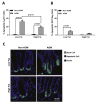Obesity promotes colonic stem cell expansion during cancer initiation
- PMID: 26455770
- PMCID: PMC4636003
- DOI: 10.1016/j.canlet.2015.10.001
Obesity promotes colonic stem cell expansion during cancer initiation
Abstract
There is an urgent need to elucidate the mechanistic links between obesity and colon cancer. Convincing evidence for the role of Lgr5(+) stem cells in colon tumorigenesis has been established; however, the influence of obesity on stem cell maintenance is unknown. We assessed the effects of high fat (HF) feeding on colonic stem cell maintenance during cancer initiation (AOM induced) and the responsiveness of stem cells to adipokine signaling pathways. The number of colonic GFP(+) stem cells was significantly higher in the AOM-injected HF group compared to the LF group. The Lgr5(+) stem cells of the HF fed mice exhibited statistically significant increases in cell proliferation and decreases in apoptosis in response to AOM injection compared to the LF group. Colonic organoid cultures from lean mice treated with an adiponectin receptor agonist exhibited a reduction in Lgr5-GPF(+) stem cell number and an increase in apoptosis; however, this response was diminished in the organoid cultures from obese mice. These results suggest that the responsiveness of colonic stem cells to adiponectin in diet-induced obesity is impaired and may contribute to the stem cell accumulation observed in obesity.
Keywords: Adiponectin; Colon cancer; Lgr5 stem cells; Obesity.
Copyright © 2015 Elsevier Ireland Ltd. All rights reserved.
Conflict of interest statement
Conflict of interest statement
None
Figures





Similar articles
-
Homeostatic responses of colonic LGR5+ stem cells following acute in vivo exposure to a genotoxic carcinogen.Carcinogenesis. 2016 Feb;37(2):206-14. doi: 10.1093/carcin/bgv250. Epub 2015 Dec 30. Carcinogenesis. 2016. PMID: 26717997 Free PMC article.
-
Establishment of a multicomponent dietary bioactive human equivalent dose to delete damaged Lgr5+ stem cells using a mouse colon tumor initiation model.Eur J Cancer Prev. 2019 Sep;28(5):383-389. doi: 10.1097/CEJ.0000000000000465. Eur J Cancer Prev. 2019. PMID: 30234553 Free PMC article.
-
Targeted Deletion of p53 in Lgr5-Expressing Intestinal Stem Cells Promotes Colon Tumorigenesis in a Preclinical Model of Colitis-Associated Cancer.Cancer Res. 2015 Dec 15;75(24):5392-7. doi: 10.1158/0008-5472.CAN-15-1706. Epub 2015 Dec 2. Cancer Res. 2015. PMID: 26631266 Free PMC article.
-
Colon carcinogenesis: influence of Western diet-induced obesity and targeting stem cells using dietary bioactive compounds.Nutrition. 2014 Nov-Dec;30(11-12):1242-56. doi: 10.1016/j.nut.2014.02.016. Epub 2014 Mar 12. Nutrition. 2014. PMID: 25280404 Review.
-
Multifaceted Interpretation of Colon Cancer Stem Cells.Int J Mol Sci. 2017 Jul 5;18(7):1446. doi: 10.3390/ijms18071446. Int J Mol Sci. 2017. PMID: 28678194 Free PMC article. Review.
Cited by
-
Obesity and intestinal stem cell susceptibility to carcinogenesis.Nutr Metab (Lond). 2021 Apr 7;18(1):37. doi: 10.1186/s12986-021-00567-y. Nutr Metab (Lond). 2021. PMID: 33827616 Free PMC article. Review.
-
AdipoRon Attenuates Wnt Signaling by Reducing Cholesterol-Dependent Plasma Membrane Rigidity.Biophys J. 2020 Feb 25;118(4):885-897. doi: 10.1016/j.bpj.2019.09.009. Epub 2019 Sep 16. Biophys J. 2020. PMID: 31630812 Free PMC article.
-
Elevated ATGL in colon cancer cells and cancer stem cells promotes metabolic and tumorigenic reprogramming reinforced by obesity.Oncogenesis. 2021 Nov 29;10(11):82. doi: 10.1038/s41389-021-00373-4. Oncogenesis. 2021. PMID: 34845203 Free PMC article.
-
Omega-3 fatty acids, membrane remodeling and cancer prevention.Mol Aspects Med. 2018 Dec;64:79-91. doi: 10.1016/j.mam.2018.04.001. Epub 2018 Apr 12. Mol Aspects Med. 2018. PMID: 29627343 Free PMC article. Review.
-
Effectiveness of Electroacupuncture for Simple Obesity: A Systematic Review and Meta-Analysis of Randomized Controlled Trials.Evid Based Complement Alternat Med. 2020 Jun 28;2020:2367610. doi: 10.1155/2020/2367610. eCollection 2020. Evid Based Complement Alternat Med. 2020. PMID: 32714399 Free PMC article. Review.
References
-
- Jemal A, Siegel R, Ward E, Hao Y, Xu J, Thun MJ. Cancer statistics, 2009. CA Cancer J Clin. 2009;59:225–249. - PubMed
-
- Calle EE, Rodriguez C, Walker-Thurmond K, Thun MJ. Overweight, obesity, and mortality from cancer in a prospectively studied cohort of U.S. adults. N Engl J Med. 2003;348:1625–1638. - PubMed
-
- Bassett JK, Severi G, English DR, Baglietto L, Krishnan K, Hopper JL, Giles GG. Body size, weight change, and risk of colon cancer. Cancer Epidemiol Biomarkers Prev. 2010;19:2978–2986. - PubMed
-
- Aleksandrova K, Pischon T, Buijsse B, May AM, Peeters PH, Bueno-de-Mesquita HB, Jenab M, Fedirko V, Dahm CC, Siersema PD, Freisling H, Ferrari P, Overvad K, Tjonneland A, Trichopoulou A, Lagiou P, Naska A, Pala V, Mattiello A, Ohlsson B, Jirstrom K, Key TJ, Khaw KT, Riboli E, Boeing H. Adult weight change and risk of colorectal cancer in the European Prospective Investigation into Cancer and Nutrition. Eur J Cancer. 2013;49:3526–3536. - PubMed
Publication types
MeSH terms
Grants and funding
LinkOut - more resources
Full Text Sources
Other Literature Sources
Medical
Molecular Biology Databases
Research Materials
Miscellaneous

